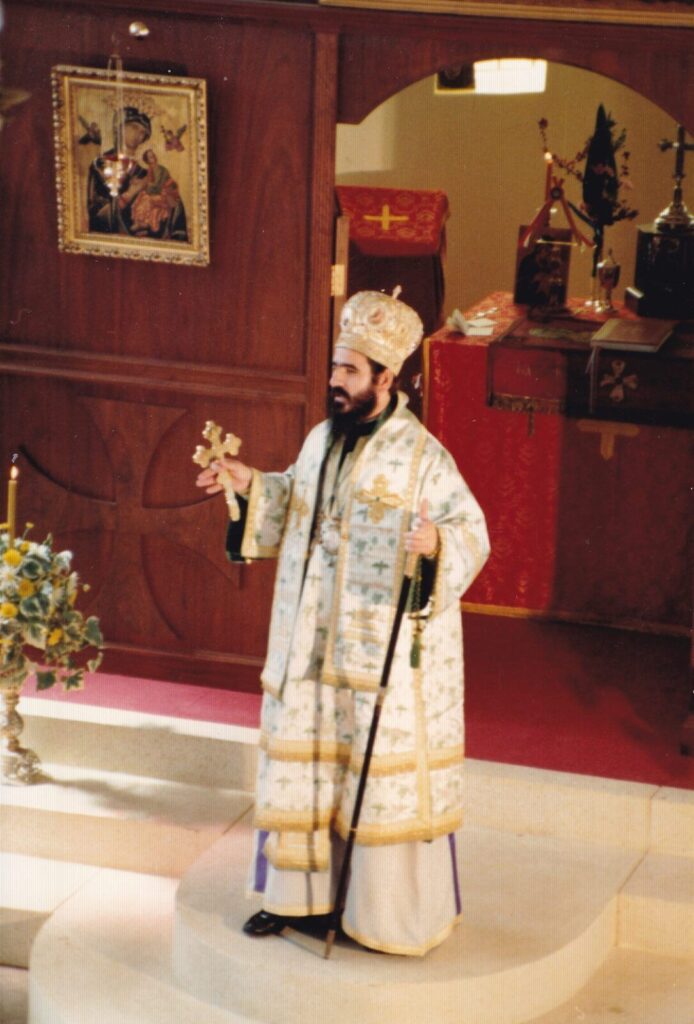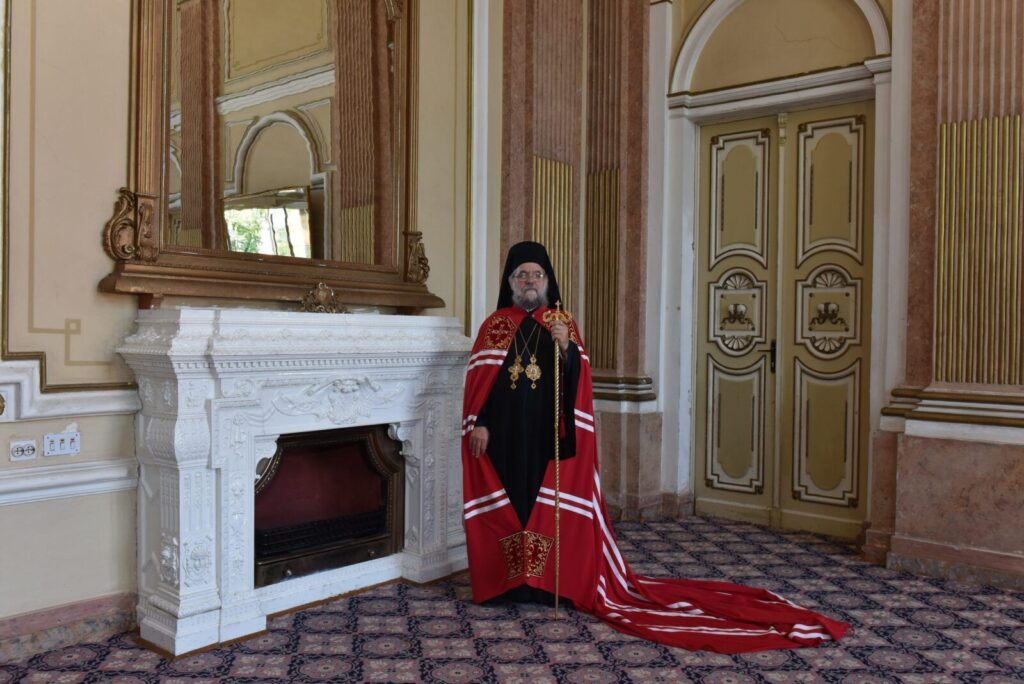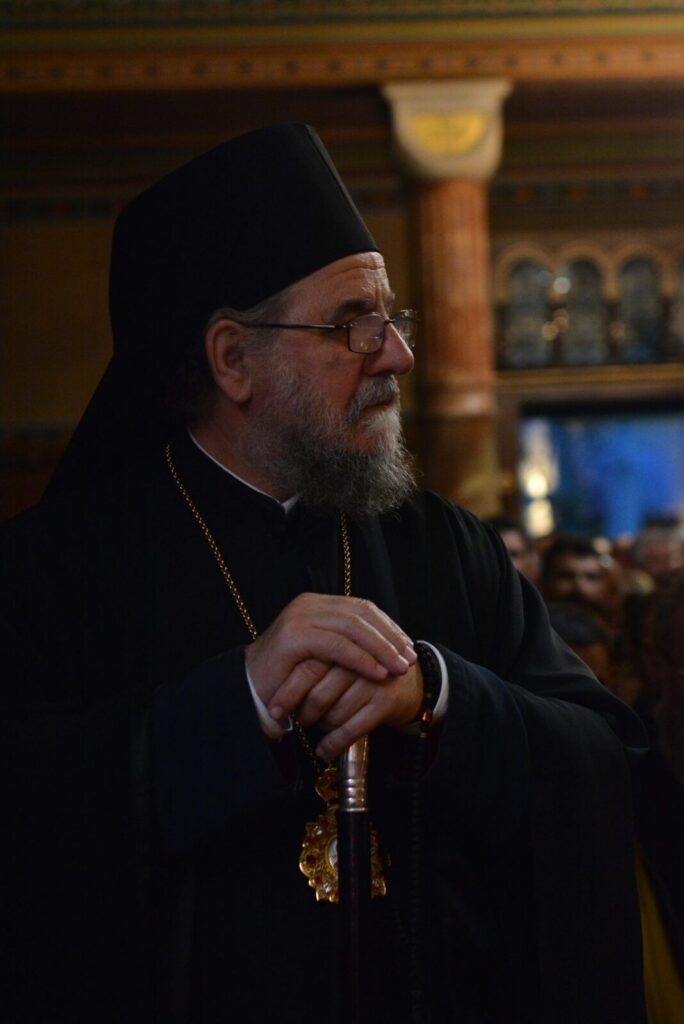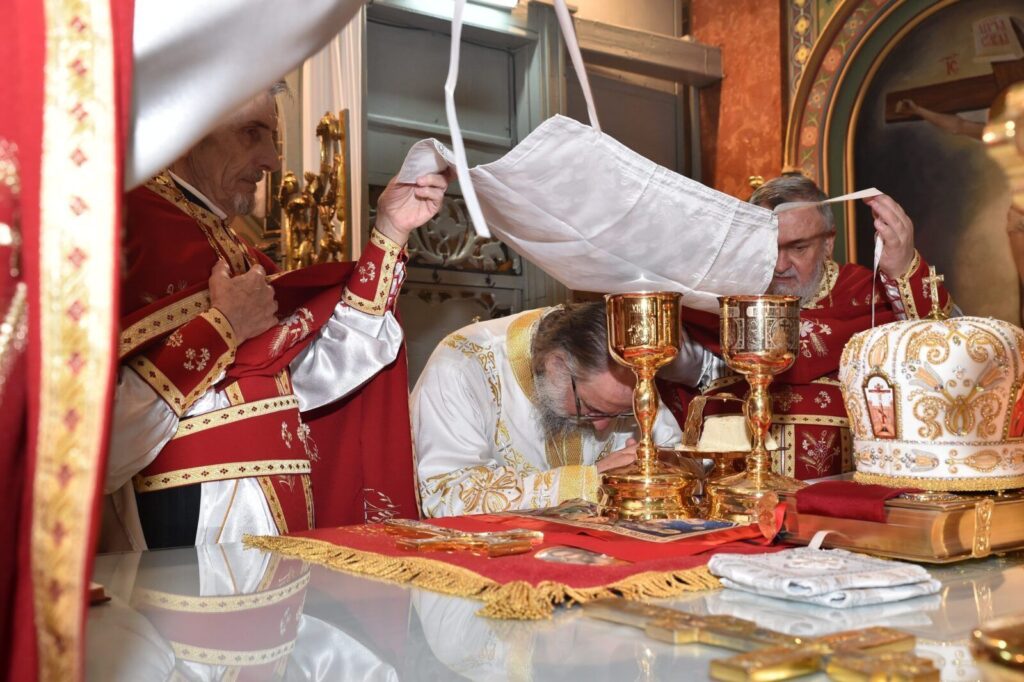His Grace the Holy Bishop of the Diocese of Srem Mr. Vasilije (Vaso Vadić) was born on December 10,
1946, in the village Opsječko, in the municipality of Čelinac, near the city Banja Luka. He grew up as the
youngest, tenth child of Luka and Jovanka Vadić, virtuous and poor Orthodox Christians, who laid a solid
foundation of steadfast faith and sacrificial love for the Church of Christ in the soul of the future
archbishop, even in his earliest childhood. These virtues will play a decisive role in the ten-year-old boy's
confrontation with a great tragedy, which painfully marked this part of his life. On Christmas Day, 1956,
after a short illness, his father dies and he remains an orphan, cared for by his mother and older
brothers.
After finishing elementary school in his hometown, in 1961, he went to the Gomirje monastery in Gorski
Kotar, where he became a novice. He learned the alphabet of the monastic feat, under very poor
material conditions, in the desolate and half-ruined sanctuary, which was built in 1602 by the monks of
the Krka monastery. He stayed with his first spiritual father, abbot Miron (Mirić), until 1964, when he
enrolled in the Seminary of the Holy Three Hierarchs, in the Krka monastery, with the blessing of Simeon
(Zloković), the bishop of Gornji Karlovac. The following words of the Holy Apostle Paul:
“Remember your leaders, who spoke the word of God to you…and imitate their faith" (Heb. 13,7), and
remembering, quite often, the good abbot Miron, Bishop Vasilije emphasizes in the conversation that he
did not have a high theological education – but he was sincerely and loyal to the monastic vow, the
Orthodox Church and his people. He also kept his "wonderful and good bishop Simeon" in his pleasant
memory.
His spiritual growth in the Krka monastery, where he would spend the next fifteen years, was overseen
by the abbot, the rector of the seminary there, Mr. Nikolaj (Mrđa), the later Metropolitan of Dabro-
Bosnia. After completing his military service, on December 20, 1966, he received monastic vows, in the
rank of small shima, from the bishop of Dalmatia, Stefan (Boca). The bitter and dangerous trials of the
Orthodox Church at that time is also evidenced by the fact that Vasilije (Vadić) was first ordained monk,
after the Second World War, in the Krka monastery. Over time, there he went through the entire ladder
of monastic obedience and duties. On Christmas 1967, in Šibenik, he was ordained to the rank of
hierodeacon, while he was ordained to the rank of protodeacon, with the right to wear a red belt, at the
end of the fifth grade of the seminary, which he graduated with excellent success in 1971.
Bishop Stefan of Dalmatia then recommended Hierodeacon Vasilije to the Holy Synod of Bishops, and he
went to the Orthodox Theological Institute of the Romanian Orthodox Church in Bucharest, where he
stayed for four full years. He took all the exams at this higher educational institution in the Romanian
language. After completing his studies, he returned to Krka, where he was appointed as a deputy of the
seminary and where, on Vidovdan in 1976, he was ordained as a hieromonk. There he performed
responsible educational duties and was a lecturer in the following subjects: Liturgy, Latin language and
Biblical history. Since he formed his psychological profile precisely in this Orthodox sanctuary, he
especially took care of the regular maintenance of worship and the orderly order of the monastery
typical. He was promoted to the rank of syncellus in the same year, on the John the Baptist Day.
In accordance with the agreement between the Anglican and Serbian Orthodox Churches, from 1973,
the Committee of the British Council of Churches awarded scholarships to local clergy during one or two
years spent at one of the English colleges or universities. Fulfilling the request of the gifted priest, the
Holy Synod of Bishops sent him to postgraduate studies in Oxford in 1977. Here, for example, he
listened to the lectures of the famous professor Timothy Ver, the latter Archimandrite and Metropolitan
Callistos of Dioclia, on the subjects History of the Christian Church and Monastic Life. While living in the
silence of the Anglican monastery of Kaolifaders, syncellus Vasilije had the opportunity to master the
purest English literary language, which was spoken by his Oxford professors.
In England, he was also elected Bishop of Australia and New Zealand, at the regular May session of the
Holy Synod of Bishops, in 1978. Having received the unexpected news, he returned to his monastery
again, where, until his ordination, he performed the usual obediences, “like any other monk”. The
ordination of the newly elected Hierarch was performed by Serbian Patriarch German (Đorić), in the
presence of several archbishops, clergy and many faithful people, on September 2, 1978. The next day,
bright and sunny September 3rd, he moved with a procession from the palace of the Serbian
Patriarchate to the Belgrade Cathedral, where he was ordained at the Holy Bishopric Liturgy, which was
served by the Serbian Patriarch German and the bishops: Stefan from Žica (Boca) and Domentijan from
Vranje (Pavlović ). On that solemn occasion, according to the old custom of the Eastern Church, Serbian
Patriarch German addressed him with instructive words:
“It was God’s will that the Holy Council of Bishops of the Serbian Orthodox Church chose you and sent
you to distant Australia to save the souls of our Orthodox brothers there, so that they too feel and be
convinced that the Mother Serbian Church has not forgotten them, that they are cared for and taken
care of, just like for his children, Orthodox Serbs in the old Fatherland. Our Church has always made sure
to send Bishops and the best priests to the most difficult places. Go there, dear Bishop, to preserve and
teach our people not to forget their old homeland, the graves of their famous ancestors, our
monasteries, customs from the old region, Easter, Christmas and to preserve the faith of their ancestors
and their language and all that is holy and congratulations to our famous ancestors. I hand over to you,
dear brother Bishop Vasilije, this scepter, a symbol of episcopal authority, a symbol of governance, a
symbol of service and a symbol of learning. Receive it and make sure that in that distant land you
answer all your duties and obligations in a worthy way, to the joy of all of us here on earth, to the joy of
the angels in Heaven, and to the greatest joy of the Risen Christ the Savior.”
His Grace the Bishop of Srem Mr. Vasilije was at the head of the Eparchy of Australia-New Zealand for eight years (1978 ̶ 1986), as its second hierarch, after the administration of Bishop Nikolaj (Mrđe). Upon arrival in Australia, the young Archbishop remains affected and deeply disappointed by the deep division of the Serbian community. The malicious antagonisms that destroyed the spiritual peace of this eparchy were rooted in the opposing ideological and political beliefs of their ancestors, as the bishop later noted: “All the old hatreds and traumas were transferred by our Serbs to the new soil and there, like poisonous hemlock, they planted. We build the monastery of St. Sava in Elaine, the schismatics immediately build another in spite, also St. Sava in Cambera.” With inexhaustible energy and resolute dedication to his mission, he goes around and gathers our people, scattered across the vast expanse of Australia, New Zealand and South Africa; teaches, advises, organizes church-school communities, around which believers gather, ordains young priests and arranges the construction of temples and public halls. In order to somehow counter the further progress of the already entrenched national “discord”, he convened the Assembly of Serbian Youth, at which lectures were given by the most distinguished intellectuals, theologians and archimandrites. In this way, the “Zaplotnja chetnik-partisan disputes” of the fathers and grandfathers of his eparchy were slowly marginalized, and he accompanied this complex and quite unusual social phenomenon with the following words:
“While other nations use historical memory to achieve unity, we Serbs seem to use historical forgetting.” What kind of irony?”
Over time, the rich fruits of the great efforts of the Australian clergy to cultivate Orthodox conciliarness have blossomed. Today, there are about one million Orthodox souls living in Australia. The Orthodox Faculty of Theology in Sydney and the Conference of Orthodox Churches were also founded. The biggest Orthodox manifestation on this continent is “Orthodox Week”, when the faithful bring icons from their homes, which are carried in a procession around the temple, followed by young men and women in colorful national costumes, under the national flags of Russia, Serbia, Greece, Syria, Romania, Bulgaria…
Bishop Vasilije's stay in "beautiful and very rich Australia", where he enjoyed the warm hospitality of
that distant country, resulted in the construction of the Saint Sava Monastery – "from the ground", as
well as new temples, halls and parish houses. Together with his clergy and a small number of monks, he
tried to establish close and friendly relations with all local Orthodox Churches, especially with the Greek
Orthodox Church and its first hierarch, Archbishop Stilian. He also maintained cordial contacts with
representatives of the Anglican and Roman Catholic churches. He traveled thousands of kilometers and
attended countless festivals, visiting his flock and reminding them of the faith of their ancestors, folk
customs and rich traditions. In this way, he vigorously opposed the destructive, assimilation processes,
which condemned their cultural and national identity to complete disappearance, "in the sea of
Protestantism or the seductive, spiritual desert of modern civilization."
By the decision of the Holy Synod of Bishops dated May 23, 1986, the Australian-New Zealand Bishop
His Grace Mr. Vasilije was appointed Archbishop of the Eparchy of Srem, with headquarters in Sremski
Karlovci. On June 15, 1986, he was inducted into the throne of the Bishop of Srem, in the Cathedral
Church of Saint Nicholas, by the hand of the then administrator of the diocese, Bishop Stefan from Žiča,
from whom he received the monastic tonsure in the Krka monastery and all other ordinations. After the
joyous welcome, which was prepared for him by his new eparchies, the bishop finds the diocese
devastated, with gaping, neglected, war wounds. For the past decades, the mere preservation of
eparchial structures and existing religious buildings, seriously threatened by unrestrained, Bolshevik
hostility, represented a truly heroic feat, carried out on their feeble shoulders by his blessed
predecessors, bishops Nikanor, Makarije and Andrej. However, on the site of the Fruška Gora
monasteries, there were still terrifying, indeed ghostly ruins. Monumental church buildings, raised and
sanctified for centuries by the prayers and tears of Orthodox Serbs, which were not completely
destroyed under the fascist occupation, were occupied by inappropriate secular institutions in a
communist state, completely insensitive to the religious needs of its population.
The Archive of the Autonomous Province of Vojvodina was forcibly moved into the neglected Patriarch's
Palace in Sremski Karlovci, where the Croatian nazis formations (ustaše) command was located during
the war, at the beginning of the communist rule. After a long and uncertain struggle, the new bishop of
Srem, with the support of the leading hierarchs of the Serbian Church at the time and members of the
Holy Synod of Bishops, Bishops Stefan (Boca) and Sava (Vuković), managed to finally evict this institution
from the "most representative Serbian home" under the Habsburg crown . Only then could all the
tragedy of the almost barbaric negligence of the management and employees of this institution,
expressed in such a shameful way towards one of the most important monuments of the Sremski
Karlovci Diocese, be seen. It took two years to paint over the darkened, dirty walls and repair the
parquet, which, for unclear reasons, had previously been coated with processed oil intended for the
maintenance of motor vehicles. With the help of people from the "Boja Sombor" company, but also with
the supervision of experts from the Institute for the Protection of Cultural Monuments, the spacious
halls of the Patriarchate were cleaned and painted, so that they would resemble the former princely
magnificence as convincingly as possible with their neat, refreshed appearance. Also, the severely
damaged roof was reconstructed, on which twelve tons of copper was placed, and the hardworking
workers, who performed this complex work impeccably, were later employed on the covering of the
Saint Sava Temple in Belgrade.
The arrival of His Grace the Bishop of Srem Mr. Vasilije at the head of the Eparchy of Srem coincided
with a dizzying change in political circumstances, which dominated human destinies in these areas for
almost half a century. After the collapse of rigid communism, state leaders began to conduct a much
more correct and benevolent dialogue with representatives of the Orthodox Church. In the coming era
of mass awakening of religiosity, it became possible again to ask for the financial or other help needed
to restore the blasphemous piles of stones, overgrown with weeds, to their former glory. Thus, the
deserted monasteries of St. Fruška Gora finally welcomed their mitron-bearing builder, restorer and
endowment. In less than ten years, since his accession to the high throne of the blessed archbishops of
Sremski Karlovci, His Grace the Bishop of Srem Mr. Vasilije, starting from the ruined Šišatovac, managed
to revive all the monastic families of his diocese. Together with Serbian Patriarch German, in Šišatovac,
he laid down the "Charter on the Restoration of Fruška Gora Monasteries, 1987", prayerfully
announcing their, in history, the most extensive and demanding, and at the same time the fastest and
most successful, material and spiritual reconstruction. Today, all these monasteries have been restored
and decorated, and in 2013, the construction of the last war victim, the Bešenovo monastery, began. At
the same time, six new monasteries were founded and built, St. Petka in Berkasovo, St. Vasilije Ostroški
in Manđelos, St. Apostle Mark in Novi Karlovci, St. Sava in Ledinci, St. Archangel Gabriel in Grabovo and
Presentation of the Blessed Virgin Mary in Sremski Karlovci. Having built a new, magnificent lodging of
the Rakovac monastery, as his endowment, His Grace the Bishop of Srem, Mr. Vasilije, ranked among
the founders of the Fruška Gora sanctuaries.
It can be said that the restoration of monasticism even surpassed the magnificent reconstruction of
priceless sacred buildings. Since the high priestship of Metropolitan Pavle (Nenadović), the families of
Fruška Gora have never had more residents than is the case today, so that His Grace the Bishop of Srem
Mr. Vasilije could state with satisfaction that in every shrine "there are some who open the doors forpilgrims, as well as pray for them to God", while their physical appearance is again comparable to the
shining state before the Second World War, especially after the restitution of nationalized church
property. In the monasteries of Srem, with a constant, arduous feat, for the salvation of the Serbian
race, but also of the entire humanity, more than 188 monastic persons pray to God every day, as well as
ten novices and eight nuns, 182 of whom were ordained as monks by His Grace the Bishop of Srem Mr.
Vasilije. In the 1980s, a total of 46 monks and nuns lived in the whole of Srem, in 14 inhabited
monasteries, including only four hieromonks. The annals of church municipalities and parishes
throughout Srem are filled with records of numerous canonical visits, divine services, wise teachings of
Mr. Vasilije, joyful throne-carryings and consecrations of temples and parish homes.
As a devotee and connoisseur of church singing, he founded a diocesan, priestly and theological choir.
Mixed choirs have been started in many church municipalities, while traditional Karlovci singing is,
among other things, preserved and nurtured in the church music course, aptly named "Cornelius in
memory", which is held every year in Sremski Karlovci.
In the end, the most convincing testimony about the personality of this meritorious Orthodox bishop
can be represented by his gestures of deep, Christian compassion towards the unfortunate, the weak
and the powerless. When, towards the end of the last century, in the year when it thundered on Saint
Sava, columns of the Serbian people with the clergy – fleeing from the pogroms, storms and flashes in
the Serbian Krajina – appeared on the roads in Srem, Bishop Vasilije opened wide the door of his soul, his
heart and home, his Church. Looking at his poor, suffering people, a tear shone in the bishop's eye,
according to many witnesses. He didn't ask too many questions, went over many answers in silence andreceived about 40 priests with their families, taking care of them in various parishes. During those
apocalyptic days and months, tons of food, clothes, shoes and other necessities were collected in church
municipalities and parishes, precisely for those who needed it.
Because of his conscientious administration of his diocese, after the death of Bishop Nikanor (Iličić),
from 1986 to 1988, he was entrusted with the administration of the Eparchy of Bačka. For six months he
also administered the Eparchy of Šabac-Valjevo, after the death of Bishop Jovan (Velimirović) in 1989.
Together with the Bishop of Bačka, Dr. Irinej (Bulović), in 1991 he founded a new Eparchy of Osijek-
Poland and Baranja, separating two vicarages from his bishopric, Vukovar and Osijek. By the decision of
the Holy Synod of Bishops, he was placed at the head of the newly founded church enterprise "Charity",
which worked within the framework of the Serbian Patriarchate in Belgrade. This establishment
consisted of a patriarchal printing house, a tailor's workshop and a tourist agency, with headquarters in
Belgrade, as well as a candle factory in Sremski Karlovci. Also, according to the decision of the Holy
Synod of Bishops, Bishop Mr. Vasilije was entrusted with the construction of the building where the
mentioned factory is located, the organization of its work and the procurement of the most modern
equipment for making candles.
He visited the Holy Land twice and worshiped the shrines there, prayed in front of the relics of Saint
Nektarios of Aegina in Greece, and according to him, whenever he had the opportunity, he made a
pilgrimage to the Hilandar monastery, "where the history of the Serbian people is most eloquently and
clearly written." As a student from Bucharest, he visited the relics of Saint Petka and other holy places
of the Romanian Orthodox Church several times, leading his theologians, while he visited the temples of
Moscow, Petrograd and other Russian cities with the choir of the Eparchy of Srem. Since the beginning
of the happy administration of His Grace the Bishop of Srem Mr. Vasilije, in Sremsk Karlovci has been
visited by the highest and most respected leaders of the Orthodox Church, among them Serbian
Patriarchs German, Pavle and Irinej, Patriarch of Moscow and All Russia Alexey II, Ecumenical Patriarch
Bartholomew, Romanian Patriarchs Teokist and Alexandrian Peter VII .



















